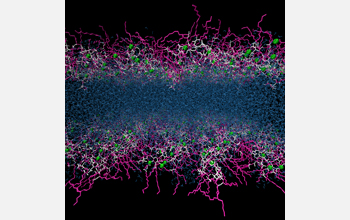Multimedia Gallery
Organic molecules on a model of sea spray aerosol (Image 3)
A cross section of densely packed, atmospherically relevant, organic molecules on a model of sea spray aerosol. Pictured are water (blue), sodium ions (green) and organic molecules (magenta and white, where magenta are aliphatic chains and white are phosphate groups).
The arrangement of molecules at the surface of sea spray aerosols influences both the chemical reactivity of those particles (implications include ground level ozone pollution) and the ability of the aerosols to form cloud droplets (implications include precipitation and freshwater shortages). The chemistry of aerosols controls their ability to react and grow into cloud droplets. However, a high level of uncertainty exists in the fundamental understanding of these processes, limiting the ability to predict the impact of aerosols on climate.
This simulation was created by the Paesani Group, which is part of the Center for Aerosol Impacts on Climate and the Environment (CAICE) at the University of California, San Diego. The group is studying the tiny particles of sea spray that are formed by ocean waves. These aerosol particles have very complex chemistry on their surface. This chemistry impacts things like air quality, weather and the formation of clouds, and possibly long-term climate.
The simulation was created with support from CAICE, a National Science Foundation Center for Chemical Innovation (under grant CHE 10-38028). (Date of Image: August 2013) [Image 3 of 4 related images. See Image 4.]
Credit: Paesani Group, University of California, San Diego
Images and other media in the National Science Foundation Multimedia Gallery are available for use in print and electronic material by NSF employees, members of the media, university staff, teachers and the general public. All media in the gallery are intended for personal, educational and nonprofit/non-commercial use only.
Images credited to the National Science Foundation, a federal agency, are in the public domain. The images were created by employees of the United States Government as part of their official duties or prepared by contractors as "works for hire" for NSF. You may freely use NSF-credited images and, at your discretion, credit NSF with a "Courtesy: National Science Foundation" notation.
Additional information about general usage can be found in Conditions.
Also Available:
Download the high-resolution JPG version of the image. (2.2 MB)
Use your mouse to right-click (Mac users may need to Ctrl-click) the link above and choose the option that will save the file or target to your computer.

